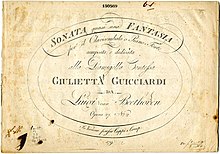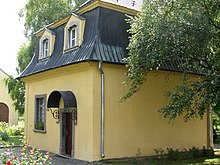Piano Sonata No. 14 (Beethoven)
The Piano Sonata No. 14 op. 27 No. 2 in C sharp minor by Ludwig van Beethoven , completed in 1801, is also known as the Moonlight Sonata .
Beethoven himself called his work a Sonata quasi una Fantasia ["as it were a fantasy "] per il clavicembalo o piano forte . The term Fantasia refers to the unusual sequence of movements in the piano sonata , the tempos of which differ from the conventional sonata form. The work does not have a first (fast) movement in sonata form , as sonatas of this time usually contain. Rather, it begins with an Adagio , followed by a livelier Allegretto with a trio, followed by a fast, highly dramatic finale that has the structure of a sonata main movement. It is noticeable here that the pace increases from sentence to sentence. Franz Liszt characterized the second movement as “a flower between two abysses”.
construction
- First movement, Adagio sostenuto, C sharp minor, alla breve, 69 bars
- Second movement, Allegretto, D flat major, 3/4 time, 60 bars
- Third movement, Presto agitato, C sharp minor, 4/4 time, 200 bars, a Neapolitan sixth chord is used several times in this movement .
History and impact
Ludwig van Beethoven was on friendly terms with the family of the Hungarian noble Brunsvik family . In the years 1800, 1801 and 1806 he stayed at the invitation of Count Joseph Brunsvik (1750–1827) on one of the family mansions, the Unterkrupa Castle . During his stays, he lived on the upper floor of the baroque gardener's cottage, where, according to oral tradition of the Brunsvik family, he is said to have composed the moonlight sonata. A small Beethoven museum has been set up in this gardener's cottage near the castle.
Beethoven later dedicated the sonata to his then 20-year-old piano student Countess Julie Guicciardi (1782–1856), with whom he was briefly in love. Apparently, this dedication was intended as “retaliation” for a gift that Beethoven had received from Julie's mother. Anton Schindler claimed in 1840 that Julie was also the addressee of the famous letter to the “ Immortal Beloved ”, which later turned out to be pure speculation.
Even during Beethoven's lifetime, this sonata was one of his most popular piano works - so popular that he himself remarked that he “wrote something really better”. With its formal freedom and its emotionally determined style, it is considered an important precursor of musical romanticism . Their formal scheme was later taken up by Robert Volkmann, among others, in his Piano Trio in B flat minor, Op. 5.
It is reported from Franz Liszt that he did not let his students play the composition because he thought it was extremely demanding. Alexander Siloti is said to have been so taken with Liszt's playing of the sonata on a Bechstein grand piano that he never wanted to hear the piece from another interpreter afterwards.
During the period in which the sonata was first becoming known, it was also known as the “Laubensonata” because Beethoven is said to have improvised the first movement in an arbor. The work was only given the popular name Mondscheinsonate later, a few years after Beethoven's death, by the music writer Ludwig Rellstab , who, when hearing the first movement , felt reminded of a boat trip on Lake Lucerne .
Another interpretation background was provided by András Schiff , who sees a rhythmic connection to a mourning scene from Mozart's Don Giovanni and takes the view that it is a “death scene” or a funeral march; and Daniel Barenboim joined this thesis. Schiff refers to Beethoven's excerpt from the scene with the dying Kommendatore in Act 1 of Mozart's opera, which Beethoven did not write until 1803/1804, and which is therefore excluded as a direct reference to the 1800/1801 Sonata op.27, No. 2 .
In the last movement of his last composition, the Sonata for Viola and Piano Op. 147, Dmitri Dmitrijewitsch Shostakovich took up motifs from the moonlight sonata and thus set another monument to Beethoven shortly before his death. The history of the impact of the piano sonata composed in 1800/1801 is not limited to works of music. It also served as a source of inspiration in both literature and the visual arts . It was the subject of numerous romantic attempts at interpretation, mostly concentrating on the slow first movement.
Issues of interpretation
pedal
For the first movement there is the playing instruction Si deve suonare tutto questo pezzo delicatissimamente e senza sordini (in German: You have to play this whole piece very gently and without a damper). “Without a damper” means “with a pedal”, but the question remains whether the whole piece should generally be played with a pedal or with a single pedal. This movement is actually played relatively seldom with a pedal held down, as in András Schiff 's Beethoven interpretation. Carl Czerny , Beethoven's student, on the other hand, writes: "The marked pedal has to be taken anew with every bass note."
tempo
The tempo designation alla breve is related to the quarter notes or the half notes in different interpretations. Although the designation alla breve clearly requires a half-measure counting method (i.e. in half notes), Carl Czerny suggests a tempo of MM 54 per quarter and that the entire sample should be played in a moderate andante tempo . András Schiff's interpretation takes Beethoven's instructions literally in terms of both speed and pedal.
character
The interpretation of Rellstab's sonata as a romantic work, inspired by a night boat trip, was contradicted by Wilhelm von Lenz , among others : he believes that Beethoven improvised the first movement on the bier of a [deceased] friend . Consequently, the dotted rhythm of the melody would be that of a funeral march, which gives the whole movement a completely different character.
Musical stylistic devices
Cadenza Doppia in its archaic form creates a romantic effect with a quarta consonans on the second beat in measure four over a long bass clause penultima and is reminiscent of its primary use in the 16th century . This idea of referring to the compositional styles of past centuries corresponds to the worldview of some composers of the 19th century . With his compositional style, Beethoven was indeed the ideal of many romantics, but he himself did not represent their worldviews.
Trivia
In the last eighteenth bar, in the third movement of Sonata 14, a cadenza begins with a sixth fourth chord . In the last fourteenth bar the resolution is in a fifth-less dominant seventh chord over “G sharp ”. There is a certain tone sequence that starts with the trill on the note "a" and ends with the "g sharp" in the small octave . The same tone sequence is used in Chopin's Fantaisie-Impromptu in bar 7 on the second sixteenth “a” of beat three to the second sixteenth “g sharp” of beat four in bar eight.
literature
- Wilibald Nagel (ed.), Beethoven and his piano sonatas, Langensalza: Hermann Beyer & Sons 1903, Volume 1, pp. 206–225
- Michael Ladenburger and Friederike Grigat, Beethoven's “Moonlight Sonata”. Original and romantic transfiguration. Accompanying publication to an exhibition at the Beethoven-Haus , Bonn: Beethoven-Haus 2003, ISBN 978-3881880770
- Rita Steblin , 'A dear, enchanting girl who loves me and whom I love': New Facts about Beethoven's Beloved Piano Pupil Julie Guicciardi. In: Bonner Beethoven Studies , Volume 8 (2009), pp. 89–152
- Kurt Dorfmüller, Norbert Gertsch, Julia Ronge (eds.), Ludwig van Beethoven. Thematic-bibliographical catalog raisonné , Munich 2014, Volume 1, pp. 160–165
Web links
- Moonlight Sonata : Sheet Music and Audio Files in the International Music Score Library Project
Individual evidence
- ↑ Beethoven's piano sonatas, on the musical content. Raptusassociation.org; accessed on June 26, 2019.
- ↑ Steblin (2009, p. 96) showed that Julie Guiccardi was not, as previously assumed, born in 1784, but two years earlier. She was not called "Giulietta" by her relatives - as such she entered the literature due to the exclusively Italian title of the so-called moonlight sonata dedicated to her by "Luigi van Beethoven" - but "Julie". (Steblin 2009, p. 90).
- ↑ Steblin 2009.
- ↑ Klaus Martin Kopitz , Rainer Cadenbach (Ed.) U. a .: Beethoven from the point of view of his contemporaries in diaries, letters, poems and memories. Volume 1: Adamberger - Kuffner. Edited by the Beethoven Research Center at the Berlin University of the Arts. Henle, Munich 2009, ISBN 978-3-87328-120-2 , p. 218.
- ^ Christoph Rueger: Franz Liszt: Contradiction of Life , page 206, Verlag Langen Müller, 1997, ISBN 978-3-7844-2607-5 .
- ↑ Volker Hagedorn: Voice of his master . In: Die Zeit , No. 13/2002.
- ↑ This connection was propagated by András Schiff in his lectures András Schiff: the lectures | Classical and opera | guardian.co.uk Music .
- ↑ Murray Perhia: Preface . In: Norbert Gertsch, Murray Perahia (eds.): Ludwig van Beethoven Piano Sonata No. 14 in C sharp minor, Op. 27 No. 2 (Moonlight Sonata) . G. Henle-Verlag, Munich 2012, p. III. PDF Online ; accessed on January 6, 2020.
- ↑ The moonlight sonata becomes foggy . In: Berliner Zeitung .
- ^ A b Carl Czerny: About the correct performance of all Beethoven's piano works. ISMN M-008-00101-7, p. 51.
- ↑ Jürgen Uhde: Beethoven's Piano Music II. Reclam, ISBN 3-15-010147-6 , p. 361.
- ↑ Johannes Menke: The family of the cadenza doppia . In: Journal of the German-speaking Society of Music Theory . tape 8 , no. 3 , 2011, ISSN 1862-6742 ( gmth.de [accessed August 24, 2018]).




